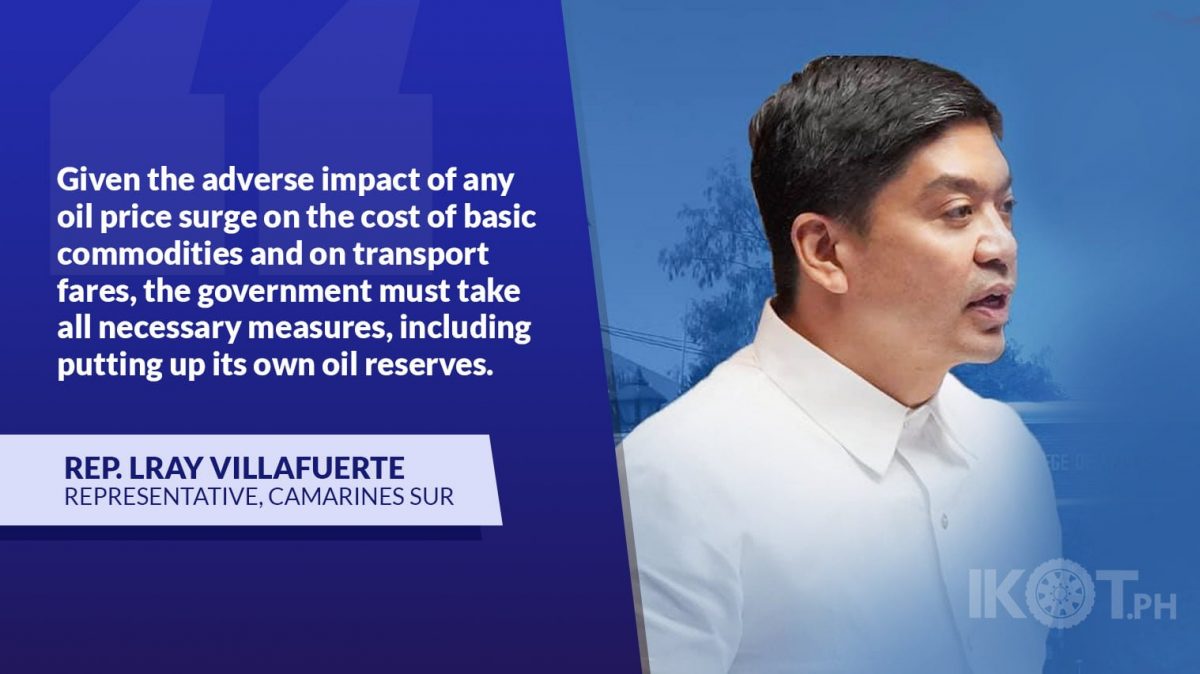Camarines Sur Rep. LRay Villafuerte has exhorted the government to accelerate plans to set up its own oil stockpile reserves to ensure stable supply and prices of petroleum products, more so now when the vaccine-driven economic recovery in the United States and Europe has started to ease travel restrictions and increase demand anew for fuel.
“The steady increase in global oil prices indicate present an upside risk that could further drive up inflation and exacerbate the economic shocks buffeting ordinary Filipinos as a result of the protracted coronavirus pandemic,” Villafuerte said
For Villafuerte, the government should study thoroughly what method of oil stockpiling would be best for the country.
The Camarines Sur legislator recalled that almost two years ago, he already backed the view by Energy Secretary Alfonso Cusi that the country needs strategic oil reserves so the government can be part of the fuel supply chain and have the capability to ease the impact of global market volatilities on consumers by ensuring a stable domestic fuel supply.
“Given the adverse impact of any oil price surge on the cost of basic commodities and on transport fares, the government must take all necessary measures, including putting up its own oil reserves, to stave off a further spike in inflation that has already gone up this year because of the abnormal jump in the retail cost of fresh pork resulting from the two-year ASF (Asian swine fever) outbreak,” Villafuerte said.
He said the recent signing by the Department of Energy (DOE) and the Japan Oil, Gas and Metals National Corporation (JOGMEC) of a Memorandum of Agreement (MOA) on a review and updating of the 2002 Philippine National Oil Contingency Plan should clear the way to the creation and operation of a Strategic Petroleum Reserve (SPR) Program.
According to the DOE on its website, this MOA was an offshoot of the DOE’s tie-up with Japan’s Ministry of Economy, Trade and Industry (METI) and JOGMEC on updating the 2002 METI study on the “Master Plan for the Development of Stockpiling for the Philippines.”
This MOA seeks, among others, to gather data on the domestic supply of, and demand for, fuel products in the past five years; projected demand for the next 20 years; the status of state-run and privately-owned storage facilities for crude oil and finished petroleum products; and a review of existing polices on supply for normal demand and for emergency situations resulting from any international or local supply disruption.
Just recently, diesel prices went up for the 10th week in a row, this time by 70 centavos per liter—or a total of P4.60 per liter as crude oil prices exceeded $70 per barrel in the world market. Gasoline prices went up by 75 centavos per liter and those of kerosene by 70 centavos per liter.
For Villafuerte, the government should study thoroughly what method of oil stockpiling would be best for the country, the logistical requirements involved, and whether crude oil or petroleum products should be stored.
He recalled that when oil prices fell in the first quarter of 2016, the DOE already considered stockpiling oil for future use, but estimates show that it would cost a staggering P300 billion a year to carry out this plan.
When the Philippine National Oil Co. (PNOC) also considered this plan earlier than 2016, the cost was estimated at P2.4 billion for 5o million liters of diesel alone.
The DOE only requires oil companies to maintain a Minimum Inventory Requirement (MIR) of in-country stocks equivalent to 30 days of crude and products for refiners, 15 days of products for importers/bulk suppliers, and seven days of liquefied petroleum gas (LPG) stocks for LPG players.
Just recently, diesel prices went up for the 10th week in a row, this time by 70 centavos per liter—or a total of P4.60 per liter as crude oil prices exceeded $70 per barrel in the world market. Gasoline prices went up by 75 centavos per liter and those of kerosene by 70 centavos per liter.
Pump prices of these petroleum products are expected to go up anew this week, with gasoline and diesel prices projected to rise by P1.05 to P1.15 per liter, and those of diesel and kerosene by a respective 60 to 70 centavos per liter and 65 to 75 centavos per liter.
According to reports, Brent crude for August recently went up by 1.9% or $1.39 to settle at $74.90 a barrel, while US West Texas Intermediate (WTI) crude for July rose 2.8% or $2.02 to reach $73.66 per barrel.


